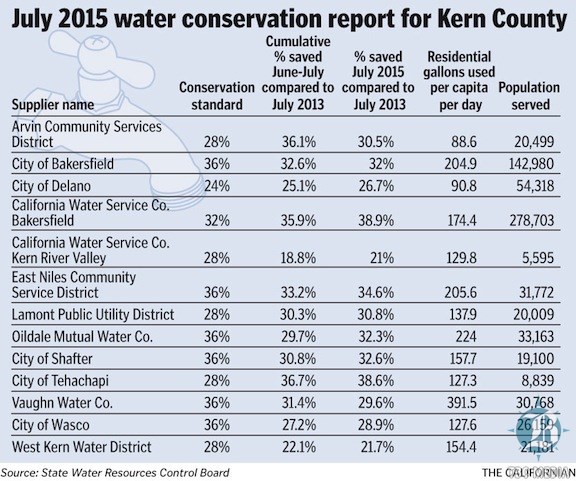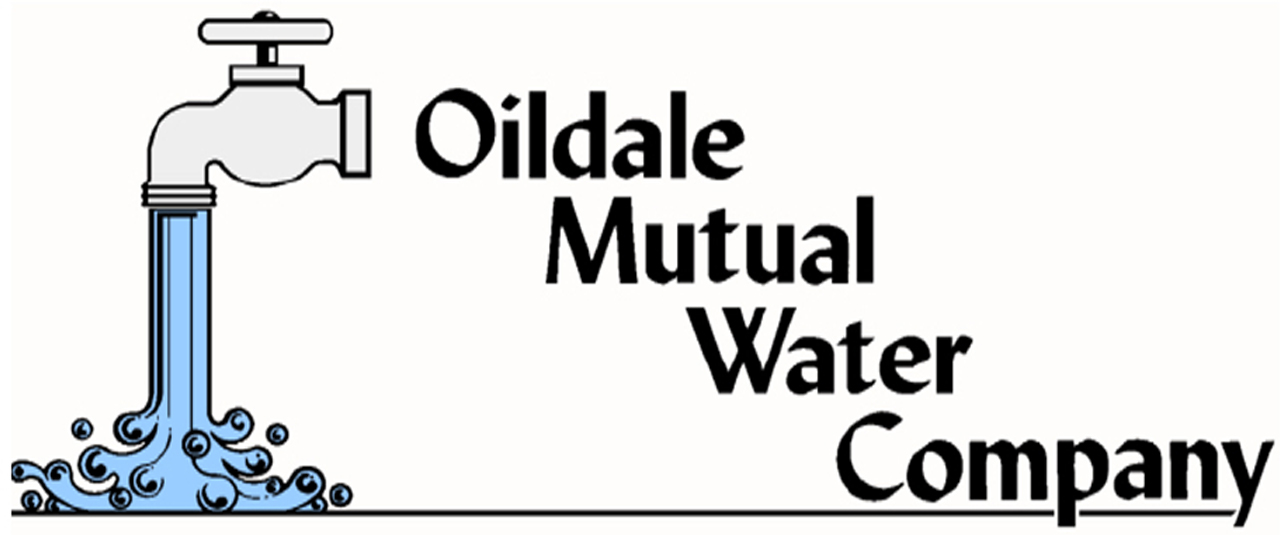July 2012 Newsletter
March 2012 Newsletter
January 2012 Newsletter
Urban Water Management Plan
What to expect when you’re expecting … a new water meter
BY THEO DOUGLAS tdouglas@bakersfield.com
SATURDAY, NOV 21, 2015 10:00 PM
It’s perhaps a little hard to believe in 2015, during an historic drought, but scattered across Bakersfield are hundreds of homes still missing one crucial suburban accessory: a water meter.
For now.
State legislation mandates all customers be on metered service by 2025.
City of Bakersfield customers, roughly one-third of residents mostly in the southwest, are all already on meters, as are water users served by East Niles Community Services District in eastern parts of the city.
But crews from the California Water Service Co., Bakersfield’s largest water company, and two smaller providers, Vaughn Water Co., and Oildale Mutual Water Co., are regularly at work installing meters and prepping for installation.
The process can typically cost companies anywhere from $600 to $1,000 per meter.
But it can sometimes save customers money if they use less water than they were being billed for on a flat rate, and as California grapples with a fourth year of historic drought, representatives of all local water agencies agree metering is a vital tool for determining how much water is being consumed.
“That’s one of the first things, if you’re going to manage your water use you’ve got to be able to measure it. That goes for the water company but that also goes for the customer,” said Van Grayer, general manager for Vaughn.
FROM FLAT RATE TO METERED
Vaughn, which serves Rosedale, is ahead of Cal Water and Oildale in the race to install meters. All but about 600 of its 10,400 connections are metered, or about 94 percent, and crews are converting more than 50 flat-rate accounts to meters every year.
Oildale Mutual, which serves Oildale, serves only around 10,000 total connections, but 5,000 don’t have meters.
Douglas Nunneley, its general manager, said the company is still completing a state grant application that will bring in $400,000 to offset the cost of installations. Crews are prepping connections for new meters but are holding off on actual installations until they get the grant.
These numbers pale in comparison to Cal Water, which serves two-thirds of Bakersfield — essentially everything except part of the southwest.
Around 19,127 of its 70,000 residential connections are still without meters, so the company has doubled installations from 2,600 a year to 5,200.
“It was going to be a 20-year program so that we didn’t burden our ratepayers but because of the drought we’ve had to shorten it,” said District Manager Rudy Valles, who estimates everyone will have meters in about four years.
Nunneley questions whether residents will see a savings when their water lines are converted from flat rate to metered, and Valles acknowledges this won’t always happen.
CAL WATER’S GRACE PERIOD
Valles said residents sometimes experience sticker shock when they see exactly how much water they’re using and what that will cost, so Cal Water keeps them on flat-rate pricing for at least three months after their meter is installed, so they can monitor their own water usage.
After that grace period is up, residents will be given a water budget based on a 2014 month-over-month average of the residential usage for the entire Cal Water Bakersfield service area.
Oildale Mutual is also contemplating giving residents time to adjust their usage once it starts installing meters.
But Cal Water construction superintendent Mary Fletcher said residents still aren’t thrilled to learn by door-hanger and letter that they’ll be getting a water meter.
“We have a lot of complaints, actually,” Fletcher said Friday as two Cal Water workers installed a water meter on a house in Hillcrest, on county-jurisdiction land in the northeast. “It’s slow going, getting the customers to buy in and not harass us when we’re out there. They don’t realize it’s not a Cal Water initiative, it’s a government mandate.”
Crews from Cal Water and its subcontractor, West Valley Construction Co., sometimes have to contend with unhappy residents, locked gates and unfriendly dogs, but on Friday it was business as usual in Hillcrest. Workers removed a familiar “water meter” cover at a home in the 2500 block of Elton Street, then dug down about two feet to expose the pipe on both sides of the company’s brass shut-off valve.
Working slowly but carefully, the pair turned off the house’s water, cut the pipe, then carefully screwed on new metal pipe with a meter, gluing PVC together on the other side to reconnect to the resident’s water line.
Foreman Jose Uribe took a few minutes to walk the neighborhood, lifting another “meter cover” on a neighboring house that would be probably be next to get a meter. The cockroaches that scurried away bothered him less than black widow spiders, Uribe said, kicking dirt across the street to show a reporter a meter cover that had been buried.
“After a while, you just see through the ground,” he said.
APPREHENSION FOR RESIDENTS
Cal Water customers are being alerted by door-hanger and bill insert that they’ll be getting a new water meter. The company also has information about the program on its website and a short video about how to read your water meter.
But that hasn’t allayed everyone’s fears about ballooning bills.
During the roughly three years her family had lived in the house, Hillcrest resident Alicia Urias said her flat-rate bill had gone up from around $60 a month to about $100. She was hopeful their cost would go down once their new meter was operational, but she remained apprehensive.
“Yeah, you know, I’ve heard a lot of horror stories about bills coming in high,” Urias said, acknowledging the finality of her family’s situation.
“Just like Pacific Gas & Electric, once you see that bill, you start cutting back real quick,” she said.
Cal Water crews usually install meters on one side of a street, then the other, like on Elton Street, where they were working Friday.
That could have meant Elton Street resident Donald Curry would have had a long wait, likely days before getting his own meter.
But as he watched workers install Urias’ new water meter across the street, Curry said he’d had Cal Water install a meter on his property more than a decade ago when his flat-rate bill was still around $40 a month.
Since then, Curry said his bill varies from around $20 in the winter, where it was last month, to nearly $50 in the summer.
“I think people will save money in the long run,” he said, “and maybe conserve water.”
Important Information About Your Drinking Water – Click on the link below
Click here to view a public notice regarding your drinking water.
Good job! Locals improve water conservation efforts
By Christine Bedell
Californians reduced their water use by 29 percent in May compared to the same month two years ago, the biggest drop since the governor called on us to sacrifice due to the drought.
Many in Kern County did even better, including customers of Cal Water Bakersfield and Shafter at 37 percent, Arvin at 35 percent and even the Rosedale area at 30 percent, according to the State Water Resources Control Board.
“The numbers tell us that more Californians are stepping up to help make their communities more water secure, which is welcome news in the face of this dire drought,” State Water Board Chair Felicia Marcus said in a news release. “That said, we need all Californians to step up and keep it up as if we don’t know when it will rain and snow again, because we don’t.”
Here’s how much customers of local water districts saved in May compared to May 2013:
Arvin Community Services District: 35%
City of Bakersfield (primarily southwest): 25%
California Water Service Company Bakersfield: 37%
California Water Service Company Kern River Valley: 27%
City of Delano: 20%
East Niles Community Service District: 34%
Lamont Public Utility District: 32%
Oildale Mutual Water Company: 30%
City of Shafter: 37%
Vaughn Water Company (Rosedale): 30%
City of Wasco: 25%
Californians cut water use 31 percent; local picture mixed

Californians again earned good grades for water savings last month, cutting overall urban use by 31 percent compared with July 2013, officials said Thursday.
As The Californian reported earlier, Bakersfield’s numbers were mixed, with California Water Service Co. customers far exceeding their 32 percent mandate but city of Bakersfield ones again missing their 36 percent mark.
It remained unclear Thursday what repercussions the city may face. State officials said they will be reviewing data in coming weeks and telling water agencies with poor track records what they may need to do.
Those officials were happy with the overall state numbers, but stressed the need for continued conservation.
“Californians’ response to the severity of the drought this summer is now in high gear,” said Felicia Marcus, chair of the State Water Resources Control Board. “Millions of conscientious Californians are the real heroes here — each stepping up to help local water resources last longer in the face of a historic drought with no certain end date.”
To reach the goal of a 25 percent reduction in overall statewide urban water use, the state board assigned water districts individual targets requiring them to cut local consumption by as much as 36 percent compared with 2013 levels.
In June —- the first month the targets were in effect —- statewide use fell by 27 percent.
Last month’s even bigger water savings were undoubtedly boosted by rare summer storms. About a third of an inch of rain fell in downtown Los Angeles, breaking a record for July precipitation that had stood since 1886.
Despite the good report card, some urban water districts have fallen well short of their targets. In June, 16 suppliers missed their goals by 15 or more percentage points. Last month four districts fell into that category.
None is in Kern County.
Locally, Cal Water Bakersfield customers made a dramatic cut, using nearly 39 percent less water last month than in July 2013. But several other local water agencies missed their targets.
Bakersfield city water users, primarily in the southwest, consumed 32 percent less water than in July 2013. East Niles Community Services District consumers used 34.6 percent less.
Oildale Mutual Water Co. users consumed 32.3 percent less water, while Vaughn Water Co. customers cut usage by 29.6 percent.
The state had ordered each of those agencies to make 36 percent cutbacks.
The West Kern Water District was mandated to reduce usage by 28 percent — but achieved less than a 22 percent cut and requested an alternative compliance order from the state because so much of its usage is tied to power plant and oil operations.
State officials said Thursday they were still reviewing requests from West Kern and other agencies.
Those that repeatedly get a bad report card face potential state fines of as much as $10,000 a day.
“We’ll reassess next month and if any of the purveyors are falling into the higher categories, we’ll be meeting with them and issuing compliance orders as needed,” said Cris Carrigan, chief of the water board’s office of enforcement.
Carrigan said it was “unlikely” compliance orders would go out to agencies coming as close to their mandated targets as many in Kern, but added, “Maybe.”
”We don’t want to see reversing trends,” he said.
But water agencies face another challenge besides mandated monthly reduction targets.
Agencies’ cumulative water use must also meet their monthly reduction targets — meaning they must save more water to make their cumulative totals rise.
Bakersfield’s water system, for example, has cumulatively produced nearly 33 percent less water since water reductions began to be enforced two months ago — short of its 36 percent target, according to Water Resources Director Jason Meadors.
“We need to make that up, we know. We’ll have to reduce water consumption over the next few months to catch up,” Meadors said.
To do so, Meadors said, city water users may have to cut their usage by approximately 40 percent in August to drop their cumulative reduction to 36 percent.
With this in mind, Water Resources Department officials are reviewing an Aug. 11 warning letter from Carrigan, which recommended considering steps including further reducing watering days, increasing staffing and budgets for water conservation, imposing fines and finding system leaks.
Bakersfield’s water resources department has already added two staffers to assist with conservation, and the city has spent more than $1 million to plug system leaks over the past year, Meadors said.
Water resources staffers are discussing other options — including fines, although talk of fines hasn’t gone too far.
“We’re doing a lot of stuff we didn’t do previously,” Meadors said, adding it was too soon to know which, if any, options could be presented to the city water board Sept. 9.
Oildale Mutual Water Co. also missed its mark in both June and July.
General Manager Doug Nunneley said he’s not proposing any new drastic mandates as a result of the new numbers, just continuing to educate customers on the need to conserve and doing more water patrolling at night.
It’s reviewing a letter from the state suggesting ways to improve, he said.
Oildale has one big thing in its favor: Its July numbers were much better than its June ones.
Nunneley said it’s tough for Oildale Mutual to post big conservation gains because it has had savings programs similar to what the state imposed this year for decades. There’s also the weather, he said.
“They don’t take into consideration the temperatures in the valley,” Nunneley said of the state. “So it’s tough.”
Given that outdoor irrigation accounts for 80 to 85 percent of people’s residential water use in the summer, Nunneley is concerned it will get harder to meet the state standards in cooler months when that drops to more like 40 percent.
One thing people can do, in addition to curtailing water use indoors, is not planting winter rye, Nunneley said.
“If they don’t plant it and we avoid all of that landscape (watering), we may be able to meet the standard with just that,“ he said.
Theo Douglas and Christine Bedell of The Californian and The Los Angeles Times contributed to this story.
In Oildale the war isn’t over oil — it’s about water
BY LOIS HENRY Californian columnist lhenry@bakersfield.com
Sure, Oildale has a reputation as a rough and tumble place. Brawling is kind of expected.
But a water fight? In Oildale?
Oh yes, and it’s gettin’ ugly.
The two main water districts up there are engaged in a bitter legal feud that will likely end up costing both entities hundreds of thousands, if not millions, of dollars.
Who do you think will ultimately bear that cost? Anyone with a faucet who lives in the ’08, that’s who.
And no matter who wins this most recent lawsuit, filed last November, the same problems will still exist, all the same complaints will eventually resurface and history will repeat itself over and over.
That’s because North of the River Municipal Water District and Oildale Mutual Water Company are trapped in a seriously dysfunctional relationship.
Oildale residents really need to get involved and demand a change in how the district and company do business. They’re the ones on the hook, after all.
And I’m not just talking about the constant legal wrangling.
The North of the River district, a public entity with elected board members who are answerable to the public (hint, hint), needs to be watched — closely.
One small peak under the floorboards was enough to make me do a double take.

